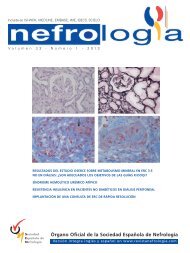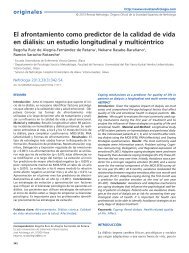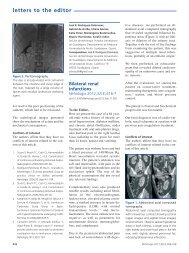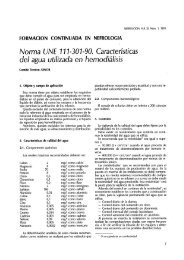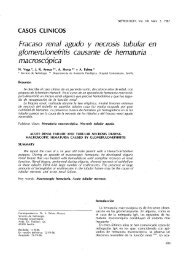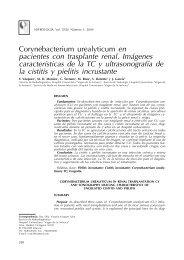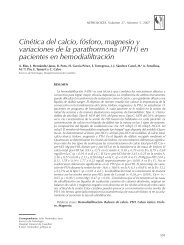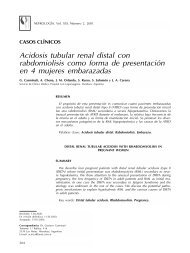originales - Nefrología
originales - Nefrología
originales - Nefrología
Create successful ePaper yourself
Turn your PDF publications into a flip-book with our unique Google optimized e-Paper software.
<strong>originales</strong><br />
El consumo de agua embotellada fue más frecuente entre<br />
los más jóvenes, y la del grifo entre la población mayor de<br />
65 años. La mayoría de la gente encuestada bebía agua del<br />
grifo pero, en cuanto a frecuencia de consumo y volumen<br />
ingerido, tanto el agua mineral como el agua del grifo fueron<br />
mucho más consumidas que los zumos, refrescos y<br />
otros líquidos.<br />
Hubo una mayor frecuencia y volumen de ingestión de líquidos<br />
en las personas que convivían con otras en el mismo<br />
hogar, particularmente con niños, y el consumo de agua<br />
embotellada, zumos y refrescos en estos hogares fue también<br />
superior.<br />
El agua embotellada y del grifo se consumió preferentemente<br />
en el domicilio, aunque también en el trabajo, mientras que<br />
el consumo de zumos y refrescos se observó más en bares y<br />
restaurantes que en el hogar y en el trabajo.<br />
Sólo la mitad de la población española está bien hidratada. Al<br />
ser el agua un líquido vital que permite el correcto desempeño<br />
de una multitud de funciones en el organismo y, en el caso<br />
de la población española, constituir parte del patrón de consumo,<br />
resulta imperioso promover su consumo y especialmente<br />
favorecer la ingestión de un agua segura bacteriológicamente<br />
y de composición constante.<br />
Agradecimientos<br />
El estudio Bahía 2008 fue patrocinado por la Sociedad Española de <strong>Nefrología</strong><br />
y contó con el apoyo económico para su realización de una beca<br />
de investigación de Aguas Font Vella y Lanjarón S.A.<br />
REFERENCIAS BIBLIOGRÁFICAS<br />
1. Whitmire SJ. Fluids and electrolytes. En: Matarese LE, Gottschlich<br />
MM (eds.). Contemporary nutrition support practice. A clinical<br />
guide. Baltimore: W.B. Saunders Co.,1998;192-201.<br />
2. Shires TG, Shires TG III, Lowry SR. Fluid, electrolyte, and nutritional<br />
management of the surgical patient. En: Schwartz SE (ed.).<br />
Principles of Surgery (6.ª ed.). New York: Mc Graw-Hill,1994;61-80.<br />
3. Grandjean AC, Campbell SM. Hidratación: líquidos para la vida.<br />
México: ILSI, 2006.<br />
4. Gallagher-Allred C. Fluid and electrolyte requirements. En: Krey SH,<br />
Murrar RL (eds.). Dynamics of nutrition support. Norwalk CT:<br />
Appleton-Century-Crofts,1986;249-75.<br />
226<br />
ALM de Francisco et al. Encuesta de hidratación en España<br />
5. Mudge G, Weiner I. Agents affecting volume and composition of<br />
fluids. En: Goodman Gilman A, Rall T, Nies A, Taylor P (eds.).<br />
Goodman and Gilman’s The Pharmacological Basis of Therapeutics.<br />
Elmsford: Pergamon Press,1990;686-707.<br />
6. Food and Nutrition Board of the Institutes of Medicine. Dietary<br />
Reference Intakes for water, potassium, sodium, chloride and<br />
sulphate. Washington: National Academies Press, 2004.<br />
7. Water UK. Working on Behalf of the water industry towards a<br />
sustainable future. Water Requirements. Adults. Nov. 2009. Accesible<br />
en: http://www.water.org.uk/home/water-for-health/medicalfacts/adults.<br />
8. Grandjean AC, Reimers KJ, Haven MC, Curtis GL. The effect of<br />
caffeinated, non-caffeinated, caloric and non-caloric beverages on<br />
hydration. J Am Coll Nutr 2000;19:591-600.<br />
9. Garriguet D. Beverage consumption of Canadian adults. Health Rep<br />
2008;19:23-9.<br />
10. Sans S, Paluzie G, Puig T, Balañá L, Balaguer-Vintró I. Prevalencia del<br />
consumo de medicamentos en la población adulta de Cataluña.<br />
Gac Sanit 2002;16(2):121-30.<br />
11. Latzka WA, Mountain SJ. Water and electrolyte requirements for<br />
exercise. Clin Sports Med 1999;18:513-24.<br />
12. Comité de Nutrición de la Asociación Española de Pediatría.<br />
Consumption of fruit juices and beverages by Spanish children and<br />
teenagers: health implications of their poor use and abuse. An<br />
Pediatr (Barc) 2003;58:584-93.<br />
13. Barquera S, Hernández Barrera L, Tolentino ML, Espinosa J, Nq SW,<br />
Rivera JA, et al. Energy intake from beverages is increasing among<br />
Mexican adolescents and adults. J Nutr 2008;138:2454-61.<br />
14. Stookey JD, Constant F, Gardner CD, Popkin BM. Replacing<br />
sweetened caloric beverages with drinking water is associated with<br />
lower energy intake. Obesity (Silver Spring) 2007;15:3013-22.<br />
15. Della Valle DM, Roe LS, Rolls BJ. Does the consumption of caloric<br />
and non-caloric beverages with a meal affect energy intake?<br />
Appetite 2005;44:187-93.<br />
16. Malik VS, Schulze MB, Hu FB. Intake of sugar-sweetened beverages<br />
and weight gain: a systematic review. Am J Clin Nutr 2006;84:274-<br />
88.<br />
17. Assy N, Nasser G, Kamayse I, Nseir W, Baniashyili Z, Djibre A, et al.<br />
Soft drink consumption linked with fatty liver in the absence of<br />
traditional risk factors. Can J Gastroenterol 2008;22:811-6.<br />
18. Armstrong LE. Caffeine, body fluid-electrolyte balance, and exercise<br />
performance. Int J Sport Nutr Exerc Metab 2002;12:189-206.<br />
19. Forshee RA, Anderson PA, Storey ML. Changes in calcium intake<br />
and association with beverage consumption and demographics:<br />
comparing data from CSFII 1994-1996, 1998 and NHANES 1999-<br />
2002. J Am Coll Nutr 2996;25:108-16.<br />
20. Duffey KJ, Popkin BM. Adults with healthier dietary patterns have<br />
healthier beverage patterns. J Nutr 2006;136:2901-7.<br />
Nefrologia 2010;30(2):220-6



